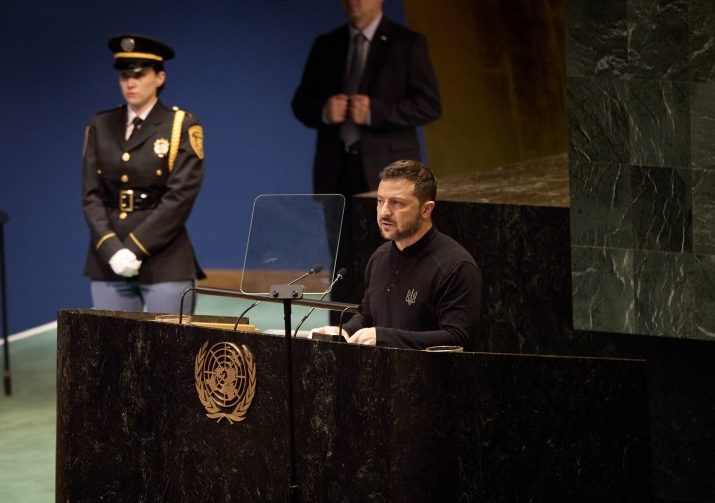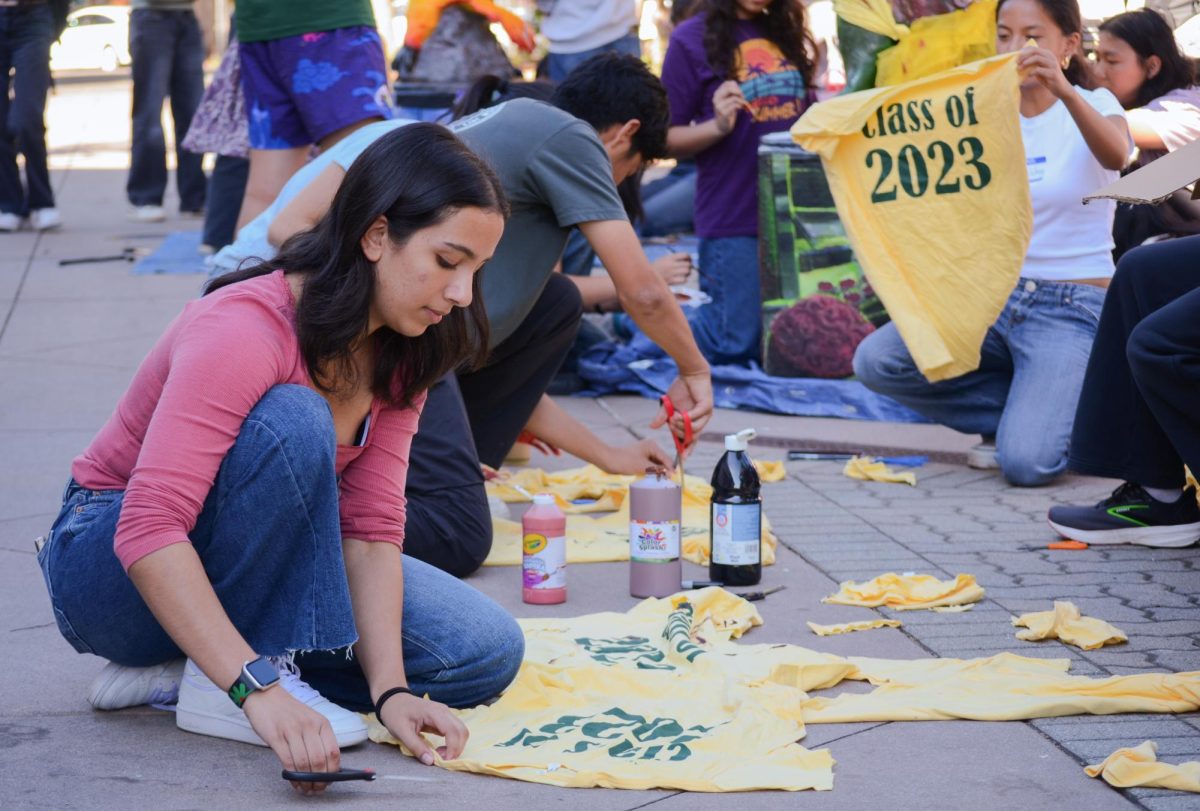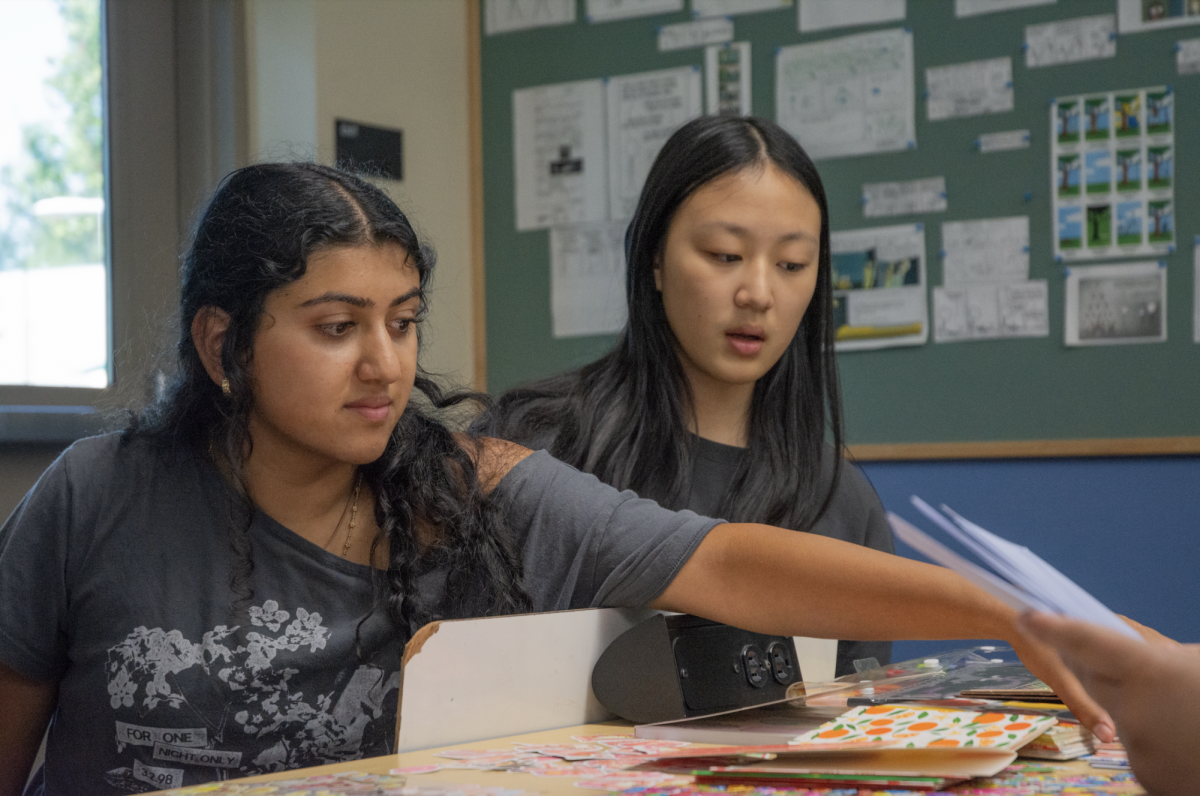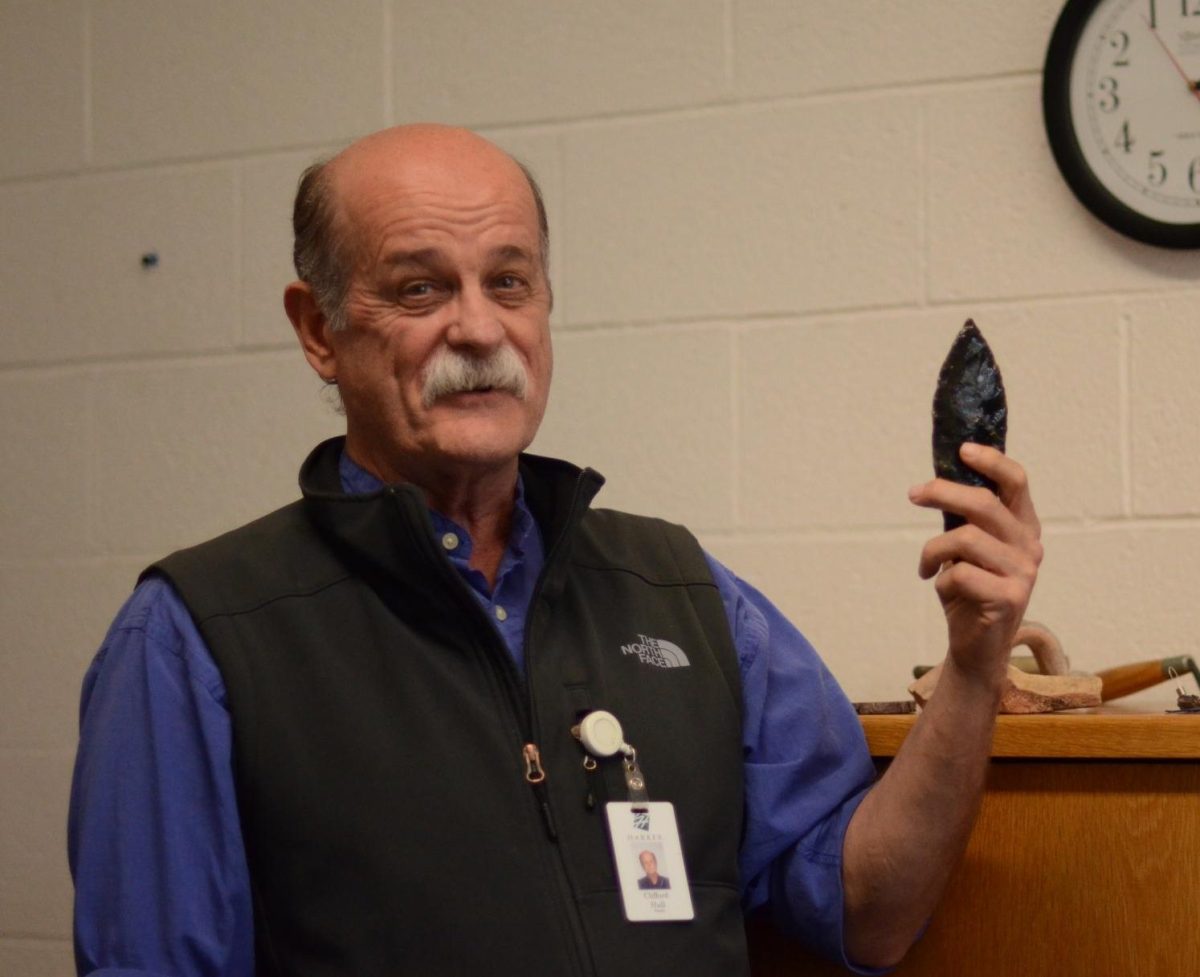A 7.6-magnitude earthquake hit the western coast of Japan at around 4:10 p.m. on Jan. 1, killing 232 people, setting off tsunami waves and causing widespread damage.
The earthquake, which struck the Noto Peninsula in the Ishikawa Prefecture, has left 22 people unaccounted for as of Tuesday. Snow and rain are increasing the risk of landslides, but rescuers continue to search through the rubble for survivors. Prime Minister Fumio Kishida announced on Jan. 4 that 3,600 additional troops would be sent to rescue people, bringing the total number of troops to 4,600. Firefighters and police are providing additional aid.
“Japan is pretty experienced with handling earthquakes,” Japanese National Honor Society president Mina Okamoto (12) said. “Of course, you can’t expect everything to be okay through a higher-than-7-magnitude earthquake, but they have a good recovery system.”
JNHS member Jasmine Ishikawa (12) was visiting her mother’s family in their hometown of Kōriyama at the time of the earthquake. The disaster did not severely affect Koriyama, which is in the west-coast prefecture of Fukushima, but Jasmine recalls receiving a phone notification and hearing sirens in the street shortly before feeling the vibrations in the ground from the earthquake.
“Japan’s earthquake notification system is really good,” Jasmine said. “If you have a phone, the emergency alert system administers it to everyone. You could hear the sirens going off, telling you there was an earthquake.”
As of Wednesday, around 15,000 people are staying in makeshift shelters, including auditoriums, school gymnasiums and parking lots. Food and water supplies are low, and power and cell services are down in some areas.
Poor timing
Japanese teacher Noriyo Ikeda noted that the earthquake, which occurred on New Year’s Day, normally a time of cheer, had a distressing effect on many Japanese people. Ikeda’s parents, who live in the east-coast prefecture of Shizuoka, were not affected. However, tsunami warnings forced her friend’s family, who live in Toyama, a prefecture neighboring Ishikawa, to evacuate.
“She was relieved because she knew [her parents] were safe,” Ikeda said. “However, they were on their way to evacuate to a shelter on the New Year, a big celebration day for Japanese people as a culture. It’s like Christmas in America. Usually we have a music show or something fun, but it was just news: TV shows got canceled because they had to report the airline crash or the earthquake.”
Ikeda referred to a collision between Japan Airlines Flight 516 and a coast guard plane at Tokyo’s Haneda Airport at 5:47 p.m. on Jan. 2. The coast guard plane was going to provide aid to the Noto Peninsula. Although all 379 Japan Airlines passengers successfully evacuated, five out of the six passengers of the coast guard plane died in the collision.
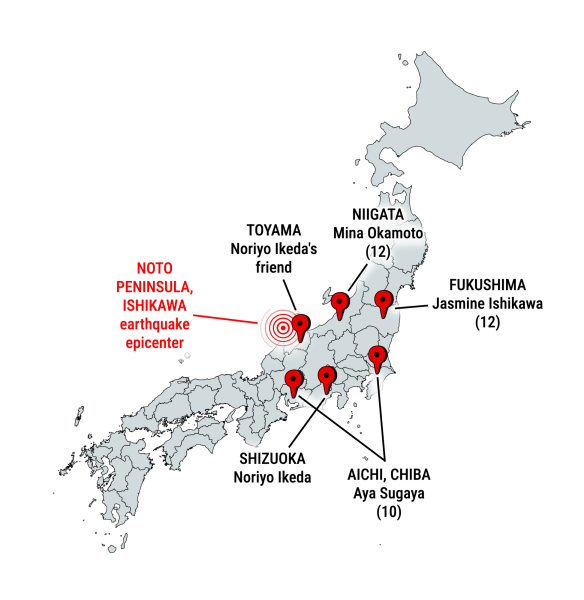
Earthquakes in Japan
Japan is particularly vulnerable to earthquakes due to its geographical location: it sits on four different tectonic plates, the North American, Eurasian, Pacific and Philippine Sea plates. In 2007, a 6.9-magnitude earthquake struck the Noto Peninsula, and in May of last year, a 6.3-magnitude earthquake hit the same region. Japan has not made a full recovery from the 2011 8.9-magnitude Tohoku earthquake on the eastern coast, the most powerful Japanese earthquake ever recorded, either. The 2011 earthquake and tsunami caused the Fukushima nuclear accident, leading to concern over the possible consequences of the 2024 earthquake.
“People are being very vigilant,” Mina said. “They’re checking other nuclear power plants around. It sounds like there hasn’t been anything concerning. But I know there are still people who are displaced from the 2011 earthquake. They’re still dealing with it.”
Systematic solutions
Members of JNHS hope for a future with more complete and efficient earthquake recovery. Mina suggested the adoption of different transport, since Japan is heavily reliant on trains, and releasing more information to those affected by earthquakes.
“A problem was that a lot of transportation was halted,” Mina said. “There were people who were stuck on trains for 11 hours, which was dangerous. That seems like something that could potentially be looked at. I wonder if they could improve on more resources, like telling people where to take shelter, where to go.”
Japan is unique in that houses depreciate over time. They become valueless in about 30 years as new earthquake technology is implemented and houses become safer. However, many people living in rural areas continue to live in older houses that lack such safety measures. JNHS member Aya Sugaya (10)’s family in the west-coast prefectures of Chiba and Aichi were not directly affected by the earthquake, but she expressed concerns about the infrastructure near the epicenter.
“I think in general, making buildings more earthquake-proof, especially in coastal towns that would be affected, is important,” Aya said. “You get a lot of that in the cities, but not in places where people are actually going to be affected.”
Ongoing infrastructure issues also leave many people out of contact with loved ones. Mina said that she could not easily contact her family members in Niigata, a prefecture near Ishikawa, because they live in a rural area.
“There were certainly not as many injuries or deaths in Niigata, but there were some, and there were tsunami warnings and evacuation warnings,” Mina said. “But I don’t really know what’s going on with [my family]. I assume they’re doing okay.”
Jasmine noted that Japan’s cell phone notification system is advanced, but because of the large elderly population, many people, especially in rural areas, do not have access to cell phones. In Suzu, a city that suffered 99 deaths as of Wednesday, 50.3 percent of its residents are elderly, according to a 2021 census. Nearby Wajima suffered 98 deaths as of Wednesday, and 43.2 percent of its residents are elderly, according to a 2015 census.
Ikeda pointed out another problem: it is currently difficult to send aid to the Noto Peninsula because of damage to major roads. The narrow peninsula has only one national highway and one expressway running through it, and landslides have obstructed parts of them. Furthermore, information about what is needed by evacuees is not made clear to people living elsewhere.
“People want to know how they can help,” Ikeda said. “Taiwan wanted to help, but the Japanese government said no because they’re not ready. They’re not ready because roads are destroyed, and if the Taiwanese government was to help, there has to be someone who translates. That kind of system was not working immediately after the earthquake happened, so they had to say, ‘No, not now.’”
Lessons to learn
Attitudes toward the earthquake may also be impacting the amount of help sent to Ishikawa. Ikeda noted that compared to the 2011 Tohoku earthquake that killed 19,759, some may think of the 2024 earthquake as “small news,” especially because it happened in a less-populated region. Jasmine believes that regardless of the death toll, the earthquake should be used as a learning opportunity.
“People should take this earthquake as a lesson for how they could be more prepared themselves,” Jasmine said. “People need to realize that there’s a lot to learn from things that happened around the world, even if it didn’t really hurt them or affect them directly.”
Jasmine hopes that people globally will learn about events like this earthquake and prepare accordingly for natural disasters in their areas. California, which encompasses the San Andreas Fault, is also earthquake-prone, and she wishes for the community to be more vigilant.
“A lot of people didn’t have a really fleshed-out earthquake plan or earthquake kit,” Jasmine said. “We don’t think of what to do in the event of an earthquake, where in our room can we take cover from an earthquake, do we have a first aid kit or anything like that. This is a piece of advice that we here in California, or in America in general, can apply: stay prepared for natural disasters.”


















![“[Building nerf blasters] became this outlet of creativity for me that hasn't been matched by anything else. The process [of] making a build complete to your desire is such a painstakingly difficult process, but I've had to learn from [the skills needed from] soldering to proper painting. There's so many different options for everything, if you think about it, it exists. The best part is [that] if it doesn't exist, you can build it yourself," Ishaan Parate said.](https://harkeraquila.com/wp-content/uploads/2022/08/DSC_8149-900x604.jpg)




![“When I came into high school, I was ready to be a follower. But DECA was a game changer for me. It helped me overcome my fear of public speaking, and it's played such a major role in who I've become today. To be able to successfully lead a chapter of 150 students, an officer team and be one of the upperclassmen I once really admired is something I'm [really] proud of,” Anvitha Tummala ('21) said.](https://harkeraquila.com/wp-content/uploads/2021/07/Screen-Shot-2021-07-25-at-9.50.05-AM-900x594.png)







![“I think getting up in the morning and having a sense of purpose [is exciting]. I think without a certain amount of drive, life is kind of obsolete and mundane, and I think having that every single day is what makes each day unique and kind of makes life exciting,” Neymika Jain (12) said.](https://harkeraquila.com/wp-content/uploads/2017/06/Screen-Shot-2017-06-03-at-4.54.16-PM.png)








![“My slogan is ‘slow feet, don’t eat, and I’m hungry.’ You need to run fast to get where you are–you aren't going to get those championships if you aren't fast,” Angel Cervantes (12) said. “I want to do well in school on my tests and in track and win championships for my team. I live by that, [and] I can do that anywhere: in the classroom or on the field.”](https://harkeraquila.com/wp-content/uploads/2018/06/DSC5146-900x601.jpg)
![“[Volleyball has] taught me how to fall correctly, and another thing it taught is that you don’t have to be the best at something to be good at it. If you just hit the ball in a smart way, then it still scores points and you’re good at it. You could be a background player and still make a much bigger impact on the team than you would think,” Anya Gert (’20) said.](https://harkeraquila.com/wp-content/uploads/2020/06/AnnaGert_JinTuan_HoHPhotoEdited-600x900.jpeg)

![“I'm not nearly there yet, but [my confidence has] definitely been getting better since I was pretty shy and timid coming into Harker my freshman year. I know that there's a lot of people that are really confident in what they do, and I really admire them. Everyone's so driven and that has really pushed me to kind of try to find my own place in high school and be more confident,” Alyssa Huang (’20) said.](https://harkeraquila.com/wp-content/uploads/2020/06/AlyssaHuang_EmilyChen_HoHPhoto-900x749.jpeg)




